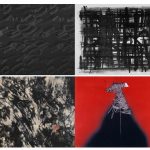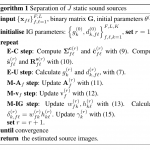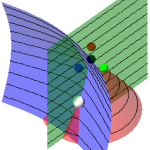- Non-Linear Matrix Completion @ CVPR’16 (Las … April 11th, 2016

Xavier Alameda-Pineda, Elisa Ricci, Yan Yan and Nicu Sebe
Advanced computer vision and machine learning techniques tried to automatically categorize the emotions elicited by abstract paintings with limited success. Since the annotation of the emotional content is highly resource-consuming, datasets of abstract paintings are either constrained in size or partially annotated. Consequently, it is natural to ...
- 2.5x @ IEEE CVPR 2016 (Las Vegas) March 10th, 2016

We’ve got two papers accepted at IEEE CVPR 2016:
Remote heart-rate estimation with self-adaptive matrix completion .
Recognize emotions from abstract paintings with non-linear matrix completion
Additionally I presented a paper on Recurrent Face Aging from the group.
References
- Weighted-data GMM @ IEEE TPAMI January 25th, 2016

Israel-Dejene Gebru, Xavier Alameda-Pineda, Florence Forbes and Radu Horaud
We recently got a paper accepted at TPAMI!
We had this crazy idea of mixture models that are trained with weighted-data. Imagine you want to train a GMM, and each data point comes with a weight denoting the relevance of the data point for the ...
- Low-rank inverse-gamma @ IEEE ICASSP 2016 (Shangai… January 20th, 2016

Dionyssis Kounades-Bastian, Laurent Girin, Xavier Alameda-Pineda, Sharon Gannot and Radu Horaud
Our low-rank parametrization of inverse-gamma distributions for speech modeling has been accepted at IEEE ICASSP 2016. The main idea is to parametrize the power-spectral density with an NMF-like model in which, even if the parameters are low-rank, the PSD is not. Indeed, ...
- The SALSA dataset December 12th, 2015

Xavier Alameda-Pineda, Jacopo Staiano, Ramanathan Subramanian, Ligia Batrinca, Elisa Ricci, Bruno Lepri, Oswald Lanz and Nicu Sebe
Keywords: Multimodal group behavior analysis, Free-standing conversational groups, multimodal social data sets, Tracking, Head and body pose estimation, Personality traits.
Synergetic sociAL Scene Analysis (SALSA) contains uninterrupted recordings of an indoor social event involving 18 subjects over 60 minutes. It serves as a rich ...
- Variational EM and non-convex optimization for mul… December 4th, 2015
Next december 22nd I will be giving a seminar at the Robot-Action-Perception team of LAAS/CNRS, whose abstract reads below.
In this talk I describe the mathematical foundations we used in the recent past to address four different multi–sensor scene analysis tasks, namely: audio-visual speaker detection and localization, separation of moving sound sources, geometric sound source localization ...
- Best Paper Award @ ACM Multimedia 2015 (Brisbane) October 31st, 2015
Xavier Alameda-Pineda, Yan Yan, Elisa Ricci, Oswald Lanz and Nicu Sebe
I happily announce that we received the Best Paper Award for
Analyzing free-standing conversational groups: a multimodal approach
at ACM International Conference in Multimedia 2015 (Brisbane, Australia) .
Abstract During natural social gatherings, humans tend to organize themselves in the so-called free-standing conversational groups. In ...
- Best Student Paper Award @ IEEE WASPAA 2015 (New P… October 25th, 2015
I am glad to announce that we got the Best Student Paper Award for
A Variational EM Algorithm for the Separation of Moving Sound Sources
at IEEE Workshop on Applications of Signal Processing to Audio and Acoustics 2015 (New Paltz, USA). See the topic’s page and .
References
- Geomtric Sound Source Localization @ EUSIPCO, WASP… October 27th, 2013

Xavier Alameda-Pineda and Radu Horaud
Keywords: multivariate optimization, hyperbolic constraints, log-barrier interior point, branch & bound.
We address the problem of sound-source localization from time-delay estimates using arbitrarily-shaped non-coplanar microphone arrays. A novel geometric formulation is proposed, together with a thorough algebraic analysis and a global optimization solver. The proposed model is thoroughly described and evaluated. ...
- AV Robot Command recognition @ ICMI & ICASSP May 17th, 2013
Xavier Alameda-Pineda, Jordi Sanchez and Radu Horaud
Keywords: audio-visual fusion, discriminative multimodal methods, robot command recognition.
We investigated the problem of choosing a classifier for audio-visual command recognition. Because such commands are culture- and user-dependant, methods need to learn new commands from a few examples. We benchmark three state-of-the-art discriminative classifiers based on bag of words ...
 Xavier Alameda-Pineda, Elisa Ricci, Yan Yan and Nicu Sebe Advanced computer vision and machine learning techniques tried to automatically categorize the emotions elicited by abstract paintings with limited success. Since the annotation of the emotional content is highly resource-consuming, datasets of abstract paintings are either constrained in size or partially annotated. Consequently, it is natural to ...
Xavier Alameda-Pineda, Elisa Ricci, Yan Yan and Nicu Sebe Advanced computer vision and machine learning techniques tried to automatically categorize the emotions elicited by abstract paintings with limited success. Since the annotation of the emotional content is highly resource-consuming, datasets of abstract paintings are either constrained in size or partially annotated. Consequently, it is natural to ... We’ve got two papers accepted at IEEE CVPR 2016: Remote heart-rate estimation with self-adaptive matrix completion . Recognize emotions from abstract paintings with non-linear matrix completion Additionally I presented a paper on Recurrent Face Aging from the group. References
We’ve got two papers accepted at IEEE CVPR 2016: Remote heart-rate estimation with self-adaptive matrix completion . Recognize emotions from abstract paintings with non-linear matrix completion Additionally I presented a paper on Recurrent Face Aging from the group. References Israel-Dejene Gebru, Xavier Alameda-Pineda, Florence Forbes and Radu Horaud We recently got a paper accepted at TPAMI! We had this crazy idea of mixture models that are trained with weighted-data. Imagine you want to train a GMM, and each data point comes with a weight denoting the relevance of the data point for the ...
Israel-Dejene Gebru, Xavier Alameda-Pineda, Florence Forbes and Radu Horaud We recently got a paper accepted at TPAMI! We had this crazy idea of mixture models that are trained with weighted-data. Imagine you want to train a GMM, and each data point comes with a weight denoting the relevance of the data point for the ... Dionyssis Kounades-Bastian, Laurent Girin, Xavier Alameda-Pineda, Sharon Gannot and Radu Horaud Our low-rank parametrization of inverse-gamma distributions for speech modeling has been accepted at IEEE ICASSP 2016. The main idea is to parametrize the power-spectral density with an NMF-like model in which, even if the parameters are low-rank, the PSD is not. Indeed, ...
Dionyssis Kounades-Bastian, Laurent Girin, Xavier Alameda-Pineda, Sharon Gannot and Radu Horaud Our low-rank parametrization of inverse-gamma distributions for speech modeling has been accepted at IEEE ICASSP 2016. The main idea is to parametrize the power-spectral density with an NMF-like model in which, even if the parameters are low-rank, the PSD is not. Indeed, ... Xavier Alameda-Pineda, Jacopo Staiano, Ramanathan Subramanian, Ligia Batrinca, Elisa Ricci, Bruno Lepri, Oswald Lanz and Nicu Sebe Keywords: Multimodal group behavior analysis, Free-standing conversational groups, multimodal social data sets, Tracking, Head and body pose estimation, Personality traits. Synergetic sociAL Scene Analysis (SALSA) contains uninterrupted recordings of an indoor social event involving 18 subjects over 60 minutes. It serves as a rich ...
Xavier Alameda-Pineda, Jacopo Staiano, Ramanathan Subramanian, Ligia Batrinca, Elisa Ricci, Bruno Lepri, Oswald Lanz and Nicu Sebe Keywords: Multimodal group behavior analysis, Free-standing conversational groups, multimodal social data sets, Tracking, Head and body pose estimation, Personality traits. Synergetic sociAL Scene Analysis (SALSA) contains uninterrupted recordings of an indoor social event involving 18 subjects over 60 minutes. It serves as a rich ... Xavier Alameda-Pineda and Radu Horaud Keywords: multivariate optimization, hyperbolic constraints, log-barrier interior point, branch & bound. We address the problem of sound-source localization from time-delay estimates using arbitrarily-shaped non-coplanar microphone arrays. A novel geometric formulation is proposed, together with a thorough algebraic analysis and a global optimization solver. The proposed model is thoroughly described and evaluated. ...
Xavier Alameda-Pineda and Radu Horaud Keywords: multivariate optimization, hyperbolic constraints, log-barrier interior point, branch & bound. We address the problem of sound-source localization from time-delay estimates using arbitrarily-shaped non-coplanar microphone arrays. A novel geometric formulation is proposed, together with a thorough algebraic analysis and a global optimization solver. The proposed model is thoroughly described and evaluated. ...